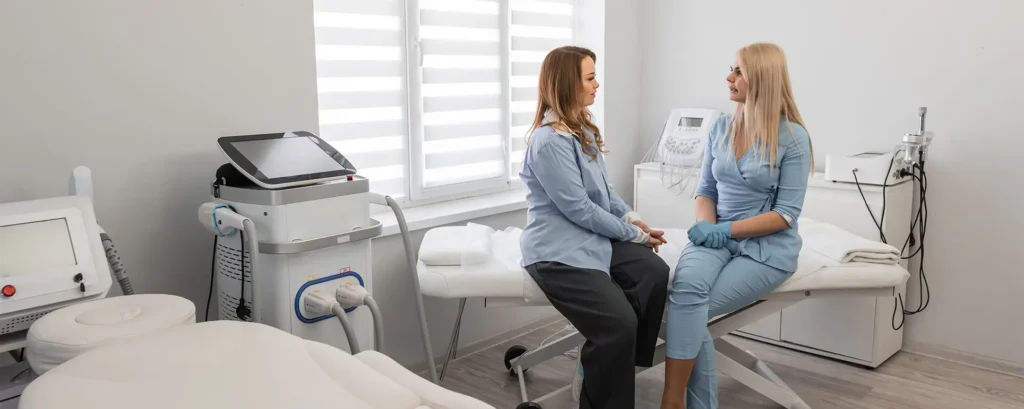Dermatology is one of the most fast-paced, visually driven areas in modern medicine. It covers everything from everyday conditions like acne and rashes to more complex autoimmune diseases and even life-threatening skin cancers. It’s a field that blends medical, surgical, and cosmetic work, offering real variety and constant intellectual challenge. If you’re considering a career in dermatology in the UK, you’ll likely be weighing up whether to work in the NHS, go private, or combine both—and each option brings its own unique rewards and challenges.
Choosing between the NHS and private practice isn’t just about salary. It affects almost every part of your working life—from how many patients you see and the types of conditions you treat, to how much autonomy you have, how much admin you’re responsible for, and the general pace of your day. With NHS waiting lists getting longer and more patients looking to private care for quicker access, the gap between the two sectors is narrowing—so it’s more important than ever to understand what sets them apart.
If you’re a medical student, junior doctor, or trainee eyeing up dermatology as your long-term path, getting to grips with the differences between public and private practice is crucial. Both aim to deliver excellent patient care, but the way that care is delivered—and what your day looks like as a consultant—can vary a lot depending on the setting. In this article, we’ll walk you through what working in each sector actually involves, from how consultants handle their caseloads and deal with admin, to how they build patient relationships and balance their professional and personal lives.
Whether you’re planning your next steps in dermatology or simply want a better understanding of how the UK healthcare system operates behind the scenes, this guide will give you a clear, honest comparison—and help you decide which path might be right for you.
Workload and Patient Volume
One of the biggest differences between working in NHS dermatology and private practice is the workload—both in how intense it is and how it’s structured. While you’ll need sharp clinical skills and good time management in both sectors, the pace and feel of the day can be very different.
- NHS: Fast-Paced with High Patient Turnover
If you’re working in the NHS, you’ll likely be seeing a lot of patients back-to-back. In a single half-day clinic, it’s common to see 12 to 16 patients—sometimes even more when demand is high and resources are stretched. You’re also under pressure to meet targets, particularly the two-week wait (2WW) pathway for suspected skin cancer cases. That urgency can make appointments feel rushed, with less time to go deep into each patient’s concerns. - Private Practice: Fewer Patients, More Time
In private dermatology, the pace slows down. You might see 6 to 8 patients in the same amount of time, giving you 20 to 40 minutes per appointment. That extra time lets you take a more thorough history, do a full examination, and talk through a detailed, personalised treatment plan. It’s a completely different rhythm—and one that many consultants find more fulfilling. - The Admin and Business Side
Of course, private work isn’t all clinical. You’ll often find yourself wearing multiple hats—handling clinic management, marketing, billing, compliance, and even thinking about patient retention. If you’re not naturally business-minded, this side of private work can be a bit of a learning curve. - Emergency Cover and On-Call Duties
In the NHS, you may occasionally be part of an on-call rota or need to handle inpatient dermatology referrals, especially in bigger or teaching hospitals. In private practice, that kind of out-of-hours work is rare—unless you choose to offer it. That can make a big difference to your evenings and weekends. - Burnout and Work-Life Balance
Let’s talk about burnout. The high-pressure environment in the NHS, especially in understaffed departments, can take its toll. Endless clinics, limited time, and heavy admin loads can lead to real exhaustion. Private work can be more flexible and financially rewarding, but the pressure to run a successful business brings its own kind of stress. It really depends on what kind of pressure you’re more comfortable managing.
Clinical Autonomy: Who Really Calls the Shots?
One of the major draws of private dermatology is the freedom it gives you in decision-making. You’re not boxed in by trust protocols or drug formularies. You can choose which treatments to offer, tailor your approach to each patient, and decide how much time you need for a consultation. That kind of autonomy is a big reason why many consultants feel more satisfied in private practice—it lets them practise in a way that aligns with their own clinical judgement and standards.
In the NHS, things are more structured. You’ll still make important decisions, but they need to align with wider hospital or trust policies. Advanced treatments like biologics or certain laser therapies might not be immediately available or could require MDT approval. Budget constraints and strict guidelines can delay access to newer options. So, while the NHS system promotes safety and consistency—especially with complex cases—it can also slow things down and limit flexibility.
You’ll really notice the difference when it comes to innovation. In private practice, you might be able to offer emerging treatments or off-label options much sooner. In the NHS, those same treatments often face delays due to red tape or funding hurdles. If you enjoy staying ahead of the curve and trying new approaches, private practice might offer a more appealing environment.
Case Complexity and Referral Patterns
In the NHS, you’ll be looking after a broad and often medically complex group of patients. You’ll see people from all walks of life—many with advanced skin conditions, rare genetic disorders, or multiple other health issues. Most referrals will come through GPs, usually via structured systems like the two-week wait pathway for suspected skin cancers. Your role won’t be limited to outpatient clinics either. As an NHS consultant, you might also handle inpatient referrals from other departments, take part in multidisciplinary team (MDT) meetings, oversee junior doctors and registrars, and contribute to training or research. It’s a demanding but incredibly rewarding job that asks a lot, both clinically and academically.
Private dermatology, on the other hand, is typically more focused on elective, non-urgent concerns. You’re more likely to see patients with issues like acne, eczema, rosacea, mole checks, or cosmetic needs like anti-ageing treatments and skin rejuvenation. Many of these patients have already been assessed or treated elsewhere—they might be looking for a second opinion, a quicker solution, or access to services not offered on the NHS. The result is a more curated caseload, with fewer emergencies and fewer patients in unstable health. That said, complex cases do still come through your door. You’ll still be called on to deal with tricky diagnoses or treatment-resistant conditions, especially if you’re seen as the “next step” after NHS care.
These differences shape not just the pace of your clinic, but also the skillset you rely on. In the NHS, you need to be a true generalist, confident across a wide range of conditions. In private practice, you’ll often find yourself going deeper into your areas of subspecialist interest, or focusing more on procedures and aesthetics.
Admin Responsibilities: Who Handles What?
Admin is another area where things diverge. If you’re working in the NHS, you’ll be dealing with electronic records, triaging referrals, managing audits, and engaging in quality improvement projects. You may also help run clinic rotas, sit on appraisal panels, or supervise training programmes.
In private practice, you’ll have more control over how things are run—but also more to oversee. Some consultants manage everything themselves, while others hire a practice manager. You’ll still need to stay on top of documentation, but you’ll also be handling (or delegating) tasks like billing, regulatory compliance, and marketing your clinic. That flexibility in designing your own systems can make things feel more efficient, but it does come with its own workload.
Time with Patients: One of the Biggest Contrasts

This is one of the most noticeable differences between the two sectors. In the NHS, follow-up appointments can be as short as 10–15 minutes. With so many patients to see and so little time, it’s hard to go into detail about lifestyle changes, prevention, or long-term management.
In private clinics, you usually have much more time—often 20 to 45 minutes or longer. That breathing room lets you really listen to your patients, explore their history, build rapport, and explain treatment options thoroughly. Many consultants who move into private practice say this time flexibility is one of the biggest perks.
Here’s a quick snapshot of how appointment time typically compares:
NHS Dermatology Appointments:
- Follow-ups often limited to 10–15 minutes.
- High volume of patients means you need to move quickly.
- Less time for detailed discussions on lifestyle or patient education.
Private Dermatology Consultations:
- Typically range from 20 to 45 minutes or more.
- More time allows for deeper conversations and tailored care.
- Easier to build strong patient relationships and cover all treatment options thoroughly.
Technology and Resources
If you’re in the NHS, access to the latest tools can sometimes be slow. Budget constraints and approval processes can delay new equipment or medications. That said, many NHS teaching hospitals are impressively well-equipped, offering cutting-edge care, particularly in specialist centres.
In private practice, you have more freedom to invest in the latest tech—like advanced lasers, imaging systems, and bespoke skincare products. This can improve both diagnostic accuracy and cosmetic outcomes, but it comes at a cost. You’ll need to factor in upfront investment and ongoing maintenance when deciding what to offer.
Training and Teaching Roles
In the NHS, teaching is a key part of the job. You’ll likely supervise junior doctors, deliver lectures, lead ward rounds, and take part in structured training programmes. It’s all part of your professional development and is valued when it comes to promotions and progression.
Private practice doesn’t usually offer formal teaching roles, but there’s still scope to get involved. You might mentor colleagues, present at conferences, or partner with universities on research. Still, if medical education is a major passion, keeping a foot in the NHS can be very rewarding.
Income and Financial Considerations
NHS salaries follow a national pay scale, and while you can earn a bit more through clinical excellence awards or extra duties, there’s a ceiling to what you’ll make. It’s reliable and stable—but not hugely flexible.
Private work offers far more financial potential, especially if you’re based in a busy city. But income depends on how many patients you see, what you charge, and how you manage your expenses. Building a successful private practice takes strategic thinking and business skills.
Work-Life Balance
In the NHS, your schedule is more structured, with predictable hours, set annual leave, and pension benefits. But pressure from full clinics, rota shortages, and heavy admin can erode that balance.
Private dermatologists often enjoy more control over their diaries, picking the hours and days they want to work. It’s ideal for those seeking flexibility—but remember, you’re also responsible for keeping the practice running smoothly and making sure the patient flow continues.
Patient Expectations and Communication

NHS patients are often more focused on accessing care than on extras. You’ll need to communicate efficiently, manage time carefully, and be clear about the limits of the service—while still offering empathy and professionalism.
Private patients expect more: shorter waiting times, thorough consultations, and clear follow-up. The bar for communication is higher, and you’ll need to balance being accessible with maintaining healthy boundaries.
Interdisciplinary Collaboration
In the NHS, you’ll work closely with other specialists—oncologists, rheumatologists, surgeons, and more. Multidisciplinary team (MDT) meetings are the norm, helping to coordinate complex cases and make shared decisions.
Private practice is more independent. You’ll still refer to trusted colleagues, but MDTs are less structured unless you’re juggling both NHS and private roles. That independence speeds things up—but it can sometimes mean less peer input.
Professional Development and Research
The NHS often supports academic growth. You might take part in research, write for journals, or present at conferences—with funding and study leave often available. If you love evidence-based practice and innovation, it’s a great environment.
In private practice, research is still possible but more self-driven or sponsored by industry. Staying academically active takes extra commitment, and many dermatologists continue NHS work partly to keep that academic door open.
Summary: NHS vs Private Dermatology
| Aspect | NHS Dermatology | Private Dermatology |
| Patient Complexity | Broad population with complex comorbidities. | Elective, curated caseload; fewer emergencies. |
| Appointment Volume | 12–16+ per half-day clinic. | 6–8 per session. |
| Time per Patient | 10–15 minutes, often rushed. | 20–45+ minutes, allowing depth. |
| Clinical Focus | Generalist care; chronic disease and skin cancer. | Often subspecialist or cosmetic focus. |
| Autonomy | Protocol-driven; influenced by MDTs and guidelines. | Greater independence in treatment and timing. |
| Innovation | Slower due to funding and regulation. | Faster access to emerging treatments. |
| Admin Workload | Triage, audits, rotas, EHRs, teaching admin. | Delegated or self-managed; includes business tasks. |
| On-Call Duties | May involve inpatient cover or on-call rotas. | Rare unless self-chosen. |
| Burnout Risk | High due to systemic pressure and staff shortages. | Business stress exists, but better schedule control. |
| Work-Life Balance | Structured hours with NHS benefits, but overloaded. | Flexible, self-determined schedule. |
| Training & Supervision | Formal roles in student and trainee education. | Informal mentorship, talks, and collaborations. |
| Technology & Resources | Limited by budget and procurement delays; varies by trust. | Invest in modern tools more freely; higher upfront costs. |
| Income Potential | Fixed salary with modest progression and awards. | Higher earning potential tied to performance and overheads. |
| Patient Expectations | Value efficiency and access; accept NHS constraints. | Expect premium service, detailed communication, and availability. |
| Collaboration (MDTs) | Regular structured case discussions with specialists. | More ad hoc; referrals and collaboration by choice. |
| Professional Development | Strong support for research, conferences, study leave. | Requires self-motivation; some split roles to stay engaged academically. |
Final Thoughts: Choosing the Right Path in Dermatology
Working as a dermatologist in the NHS or private sector comes with distinct responsibilities, pressures, and rewards. The NHS offers collaborative practice, teaching, and wide-ranging clinical exposure, albeit with heavier administrative loads and shorter consultation times. Private practice provides greater autonomy, potentially higher earnings, and the opportunity to develop personalised, patient-focused care—but it also demands entrepreneurial skills and operational oversight.
Ultimately, many consultants find fulfilment in a blended model, combining the structure and team-based care of the NHS with the flexibility and innovation of private practice. The best path depends on your values, professional goals, and preferred work environment.
References:
- British Association of Dermatologists (BAD), 2022. Guidance for Dermatology Services in the UK: Consultant Workload and Capacity Planning. Available at: https://www.bad.org.uk
- Health Education England, 2021. The Future Doctor: A Vision for the NHS Workforce. London: NHS England. Available at: https://www.hee.nhs.uk/our-work/future-doctor
- Royal College of Physicians, 2022. Consultant physicians working with patients: The duties, responsibilities and practice of physicians in medicine.
- NHS Digital, 2023. NHS Hospital Outpatient Activity 2022–23: Dermatology Specialty Analysis.
- Wong, D., Marks, R. and Ormerod, A., 2019. Consultant dermatology in private practice: Clinical autonomy, patient satisfaction, and operational differences. Journal of Dermatological Treatment, 30(7), pp.684–690
